2012, Volume 18, Issue 1
Effect of high acceleration exposure on visual perception in Polish pilots measured with critical fusion frequency test (CFFT)
Olaf Truszczyński1, Mieczysław Wojtkowiak2, Rafał Lewkowicz3, Marcin Biernacki4, Krzysztof Kowalczuk3
-------------------------------------------------------------------------------------------------
1Zakład Bezpieczeństwa Lotów, Wojskowy Instytut Medycyny Lotniczej
2Zakład Fizjologii Lotniczej, Wojskowy Instytut Medycyny Lotniczej
3Zakład Treningu Lotniczo-Lekarskiego, Wojskowy Instytut Medycyny Lotniczej
4Pracownia Psychologii Eksperymentalnej, Wojskowy Instytut Medycyny Lotniczej
Autor korenspondencyjny: Olaf Truszczyński; Zakład Bezpieczeństwa Lotów, Wojskowy Instytut Medycyny Lotniczej; email: otrusz[at]wiml.waw.pl
Autor korenspondencyjny: Mieczysław Wojtkowiak; Zakład Fizjologii Lotniczej, Wojskowy Instytut Medycyny Lotniczej
Full text
Streszczenie
Introduction. The relationship between flicker sensitivity and acceleration, impaired stimulation and inhibition of central and autonomic nervous system and, ophthalmologic function. It should be stressed that examination of visual perception in pilots with CFFT can be interesting. Objectives: The purpose of this study was to determine the effect of high positive sustained acceleration on visual perception as measured with a CFFT (Critical Fusion Frequency Test) and to determine the relationship between these changes with respect to +Gz exposure. Participants and methods: Thirty-one volunteers aged between 23 to 30 years participated in the study. All of them underwent training and examination in the MIAM (Military Institute of Aviation Medicine) prior to, during and after exposure to acceleration on a human centrifuge. Participants were divided into three groups, depending on their Acceleration Tolerance Level (ATL) in order to compare their +Gz tolerance with CFFT results. Results:No statistically significant differences were found between the changes in the CFFT control value (+1 Gz, no centrifugation) and > 1Gz exposures. Sequentially performed measurements, also resulted in no statistically significant changes. Conclusions: The obtained results indicate the CFFT has no value in the evaluation of a pilot’s visual perception during acceleration exposure.
Słowa kluczowe
acceleration, CFFT, pilots
